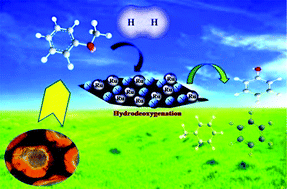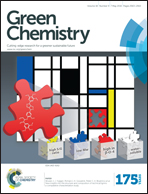Vapour phase hydrodeoxygenation of anisole over ruthenium and nickel supported mesoporous aluminosilicate
Abstract
Mesoporous aluminosilicate (Al-SBA-15) support synthesised via a direct hydrothermal method was post loaded with monometals such as 1.0 wt% RuO2 and 7.0 wt% NiO separately. Different weight percentages of bimetallic catalysts such as RuO2 (0.2–1.0 wt%) with 7.0 wt% NiO were loaded jointly on mesoporous Al-SBA-15 support by a wet impregnation method for hydrodeoxygenation of anisole. The XRD and BET results revealed that the materials were hexagonally ordered, indicating the presence of mesoporosity. NH3-TPD results confirmed the presence of acidic sites on materials, which enhanced the HDO activity of anisole. The oxidation state of Ni2+ and Ru4+ was confirmed by XPS analysis. H2-TPR revealed the strong metal-support interaction in monometal catalysts of 7.0 wt% NiO, whereas in the case of bimetallic catalysts the reduction temperature of Ni was lowered below 440 °C by addition of Ru, which is lower than the that of 7.0 wt% NiO (524 °C). HR-TEM images further confirmed the presence of the mesoporous nature along with RuO2 and NiO crystallites largely located over the surface of Al-SBA-15. The activity of all the synthesised catalysts was tested over vapour phase hydrodeoxygenation of anisole (biomass compound). Variation in temperature and time-on-stream with atmospheric pressure was optimised to obtain high conversion and selectivity. A reaction temperature of 400 °C was found to be optimum. The 1.0 wt% RuO2/7.0 wt% NiO catalyst gave the highest conversion of about 46% of anisole and selectivity towards benzene of 45%. Bimetallic catalysts (1.0 wt% RuO2/7.0 wt% NiO) showed high activity compared with monometallic catalysts (1.0 wt% RuO2 and 7.0 wt% NiO) because of the synergism of Ni and Ru. Also the bimetallic catalysts showed good activity compared with other reported catalysts under variable experimental conditions.


 Please wait while we load your content...
Please wait while we load your content...